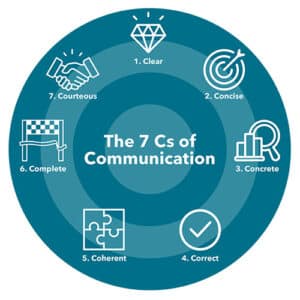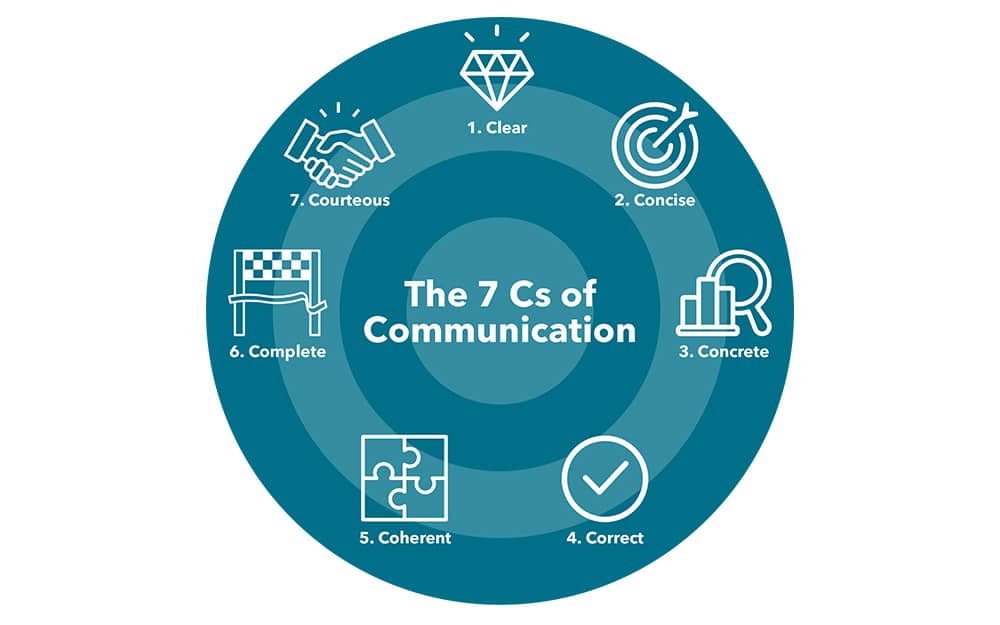Home | HR Perspective | Mastering the Seven C’s of Communication
HR Perspective
Mastering the Seven C’s of Communication
Lessons Learned from a Peanut Butter Sandwich
Seek first to understand, and then be understood—wise words from one of the first professional productivity teachers, Steven R. Covey. Understanding and being understood—effective communication—are the bedrock of our professional and personal relationships. Poor communication can trip up even the simplest tasks.
A few months back, I was heading home from a work trip. It was after five in the afternoon, and my wife asked me to pick up dinner on my way. We do this occasionally, as I drive out of town several times a month. She places the order, and I bring it home for a nice dinner together. We usually communicate this through text messaging, and it works great. Except this time. She placed the order at a local chain restaurant in the city where I was working, and I went to a sister restaurant in a city 60 miles away. The peanut butter sandwich I had for dinner that night taught me a good lesson about communication.
The truth is that neither of us were technically at fault. We both missed critical elements in communication. She did not give a complete message, leaving out details like where the order was placed. I was not curious enough, made assumptions, and didn’t bother to confirm the specifics. And that is how you get a peanut butter sandwich for dinner.
I believe communication is the most important factor in building and maintaining successful organizations. It is critical that leadership regularly shares the vision and purpose of the organization with staff, clients, and customers. Operational effectiveness is based on having the right people in the right place at the right time. Training is about understanding expectations and job duties. None of this happens properly without communication. Leaving a customer standing at the counter, not having special event staff in their spot, or giving out the wrong password for the software gives the impression that the members of an organization cannot handle their jobs. It is demoralizing to customers and staff.
Modern phones, devices, apps, and cloud-based software have allowed us to communicate as never before. These amazing tools enable us to communicate rapidly and in great quantity, even live video from almost anywhere. These are not new technology; the smartphone is over 20 years old. But somehow, we still fail to communicate effectively more often than we should.
The basics of communication are the same as they were 1,000 years ago when we used handwritten notes and word of mouth to communicate across large areas. The basics need to be applied to modern communication tools. There is no magic formula for good communication; it is just a matter of incorporating good habits into your daily work routine.
Plenty of publications and websites promise to unlock the keys to communication in a few easy steps. As always, the small steps are far easier said than done. However, much of the published material contains the same basic guidance for effective communication.

- Clear.
- Concise.
- Concrete.
- Correct.
- Coherent.
- Complete.
- Courteous.
Each of the Seven C’s needs to be understood and customized to meet your organization’s needs. However, these characteristics of effective communication span across all platforms. From handwritten post-it notes, messaging software, emails, memos, and reports to speaking with one another, utilizing these criteria can help you effectively communicate with your internal teams and customers. It is easy to see how omitting even one element can impact the message. For example, failing to be courteous can change how the recipient of your message perceives your attitude toward the information and their willingness to follow through.
The Seven C’s help us understand that both the sender and receiver are responsible for communication. Miscommunication is usually a shared event with failure by both parties. Senders must know their audience, be concise and clear, and ensure the communication’s goal is understood. Receivers must pay attention, clarify ambiguity, and work to understand the communication’s intent and specifics.
Hopefully your organization does not have to eat too many peanut butter sandwiches from communication failures. Having a full buffet of effective communication each day would be great, but that doesn’t always happen. Great organizations and employees work to recognize their shortcomings and improve communications continually. Communication skills are never a finished product, and with training, practice, and success, we can build our proficiency and equip our organizations to deliver great products and services. ◆
Don’t miss IPMI’s Frontline Fundamentals session on June 26, 2024, at 2:00 p.m. EST, where Jon will present this important content. Click here to sign up for this session, free for IPMI members!
 All 2024 Free Frontline trainings are generously supported by our exclusive sponsor, FAAC Parking Solutions.
All 2024 Free Frontline trainings are generously supported by our exclusive sponsor, FAAC Parking Solutions.
Jon Forster, CAPP, NCI, is a Parking and Mobility Planner with Fishbeck.
- This author does not have any more posts.













